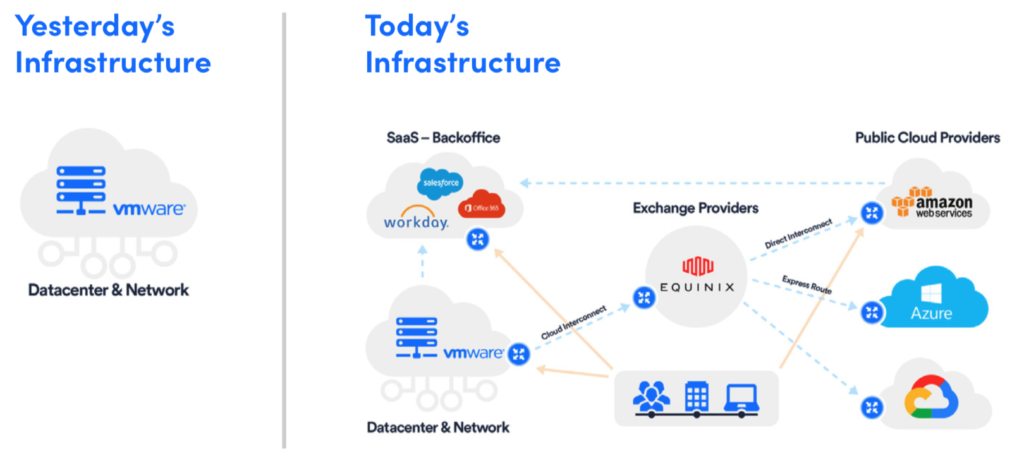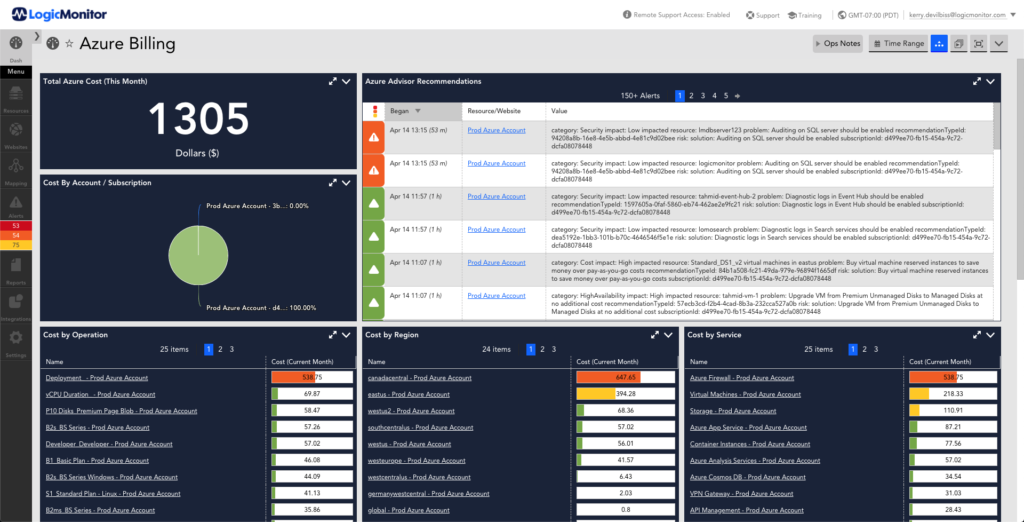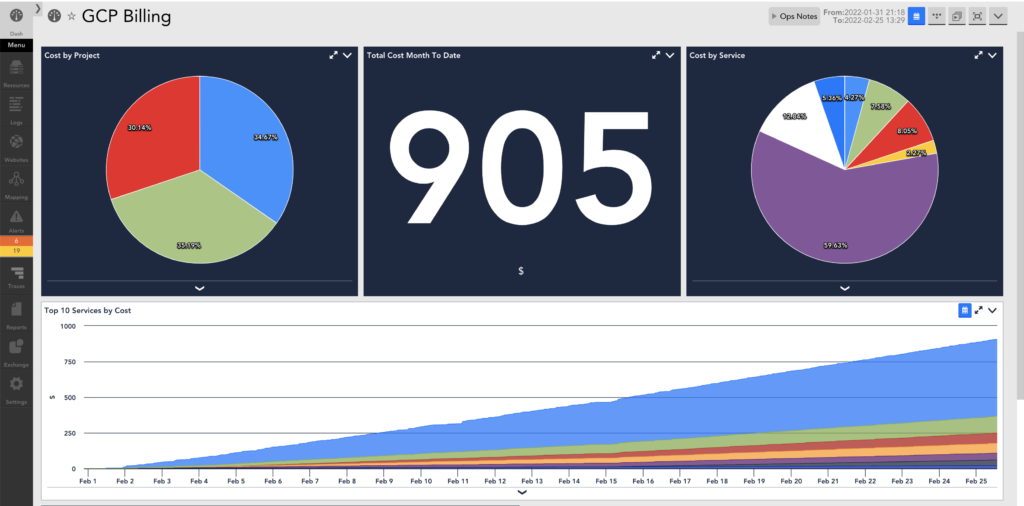In recent years, just about every organization across the globe transformed digitally. The abrupt move to remote work forced many businesses to ramp up their digital capabilities. Whether by eliminating manual processes and introducing automation, migrating to the cloud, or moving to a mobile-first approach, businesses continue to adapt to the evolving IT landscape. Though a digital transformation introduces its fair share of technological complexities and challenges, it remains critical for businesses to succeed.
Today, the IT infrastructure supporting most businesses has also transformed – from a completely controlled environment to a distributed software platform composed of public cloud, private cloud, and on-prem. Yesterday’s predominantly on-prem monitoring tools are not compatible with today’s hybrid demands. These legacy tools were designed to focus on smaller, localized infrastructure, while today’s software-forward infrastructure requires a flexible, scalable, and intelligent monitoring solution.
In order to monitor such a diverse and complex infrastructure, many businesses opt for a Software-as-a-Service (SaaS) monitoring platform. A SaaS monitoring platform provides complete visibility into your entire tech stack, including other SaaS applications, cloud platforms and services, and physical devices – no physical installation necessary. This solution is designed to monitor any type of infrastructure – hosted anywhere in the world – while providing a seamless experience for users. In this article, we unpack 10 reasons why SaaS monitoring is necessary to meet the growing demands of today’s IT landscape.


1. Break operational silos
Many businesses have invested in several different monitoring tools over the years. Using different tools for monitoring, visualization, and alerting is also known as tool sprawl, which not only leads to complications in operations but also causes silos within IT. This results in little to no sharing of data between the applications, infrastructure, and networking teams.
Consider how much time can be saved by using the same platform to keep track of mission-critical data. A SaaS monitoring platform not only provides role-based monitoring capabilities but also correlates the data between the different layers of your infrastructure to pinpoint exactly where the problem is across all your ops teams. This will significantly reduce Mean Time to Detection (MTTD) and Mean Time to Resolution (MTTR).
2. A hybrid infrastructure needs hybrid monitoring
Many IT infrastructures today are largely hybrid in that there are different parts of the tech stack running in the organization at any given time. For example, the back-office, productivity, and unified communications applications may be running largely in SaaS. Some applications may be running in AWS, Azure, or Google Cloud, and older servers may still be on-premises. And now that it is possible to create a software-defined data center without investing a penny in hardware, this can complicate monitoring efforts.
In order to manage your tech stack effectively, you likely need a sophisticated, centralized SaaS monitoring platform that can understand your infrastructure’s complexities and continuously identify issues that may impact the business. A SaaS monitoring platform can provide near real-time visibility into your global infrastructure and simultaneously focus on the localized needs of your team.


3. Free up time to focus on what you do best
Gone are the days when operations teams needed to focus on downloads, installation, upgrades, availability, performance, security, and other intricacies involved in setting up and managing a monitoring platform. A dedicated SaaS monitoring partner will work in the background to keep your business up and running, allowing your team to pivot from troubleshooting to driving value in doing what they do best.
4. Benefit from economies of scale
Take advantage of economies of scale in the cloud. A true multi-tenant SaaS platform should be designed to scale linearly with growth and achieve economies of scale by optimizing the cost of the shared infrastructure over time.


As time progresses, the scaling event time span also increases, offering economies of scale over time. For your SaaS vendor to survive long-term and pass on the economies of scale to you, a scalable multi-tenant platform is fundamental. The benefit of SaaS is that it is independent of on-premises, remote data centers, and workloads in the public cloud. It is always on. This boosts team productivity – through efforts like automation – and decreases resource cost for things like maintaining legacy tools. An always-on SaaS solution keeps the business running and scales with you as you grow.
5. A monitoring partner is a dedicated, expert resource
The more complex your operations and tech stack, the more you need an enterprise-level monitoring tool. Using multiple built-in tools or building a DIY system is both time-consuming and inefficient. This can also put your business at risk if it hinders meeting your service level agreements (SLAs).
A monitoring system is a mission-critical source of information about your global systems and therefore needs dedicated personnel managing it. A well-designed monitoring system could be more complex than the systems it monitors because it is streaming data from different types of hardware and software within your organization, correlating that information, and analyzing the data to find issues. As businesses scale, it becomes difficult to manage the volume of data without the proper resources in place. A dedicated monitoring partner can be a massive asset, not only to IT, but to the whole business.


6. Opportunity cost outweighs operational cost
Infrastructure health can be tied directly to business value. Building a custom monitoring system might seem simple but can quickly get complicated to install, maintain, update, and run. While SaaS monitoring platforms might be expensive, the link between infrastructure health and business value is high. Now, IT teams can measure how changes in infrastructure health affect the bottom line, and SaaS vendors can even forecast issues and solve problems instantly. All of this leads to better productivity and increased efficiencies, which outweigh operational costs.
7. Guaranteed cloud compatibility
Cloud is here to stay, and most organizations are exploring ways to take advantage of multiple clouds. If you use Salesforce, Workday, Office 365, AWS, Azure, or another comparable solution, you are already sending highly secure information into the cloud. By partnering with a SaaS provider, you can trust that their systems will stay current with updates and certifications as they are required.
Thanks in part to LogicMonitor SaaS, we’ve reduced monitoring operations to a level that it no longer requires a separate team solely dedicated to monitoring. We’ve decided to move responsibility for our core monitoring platforms to another team in IT called ‘Common Platforms’.
LOGICMONITOR CUSTOMER
8. Automatic upgrades
Say goodbye to manual platform upgrades. With traditional licensed software, every upgrade requires significant time and energy. From putting together a project team and conducting risk analysis to ensuring the upgrade is completed during specific windows, the process can be daunting. Many traditional upgrades also require devices to be offline, which can be difficult to plan and communicate. And skipping the upgrade is not an option due to security implications. Most SaaS providers run collectors or agents to provide automatic upgrades. A mature SaaS monitoring platform gives you the choice of automatic upgrades and lets you control the process based on your needs.
9. Reduced cost and greater ROI
With SaaS monitoring, your monitoring costs will reduce drastically over time. An on-premises monitoring system can be expensive, and with the upkeep required, it can be more expensive than a SaaS solution. Additional costs like backup and restore, failover, risk, feature advancements, and opportunity cost are also considerations.


10. One source to hold accountable
With a SaaS-based solution, the responsibility to continue monitoring according to security best practices is the vendor’s responsibility. A dedicated SaaS vendor will continue to evolve and enhance their solution, which directly benefits you, the customer. It can be tremendously difficult to stay on top of regular updates and product enhancements when you’re handling deployments in-house. In a SaaS platform, the vendor upgrades for all customers at once. Your only requirement as the customer is to choose from the features you want to use and the platform works as a central, always-current monitoring system that automatically scales with your infrastructure.


Expand what’s possible with LogicMonitor
LogicMonitor®’s SaaS-based observability and IT operations data collaboration platform helps ITOps, developers, MSPs and business leaders gain visibility into and predictability across the technologies that modern organizations depend on to deliver extraordinary employee and customer experiences. LogicMonitor seamlessly monitors everything from networks to applications to the cloud, empowering companies to focus less on troubleshooting and more on innovation. For more information, visit www.logicmonitor.com.
